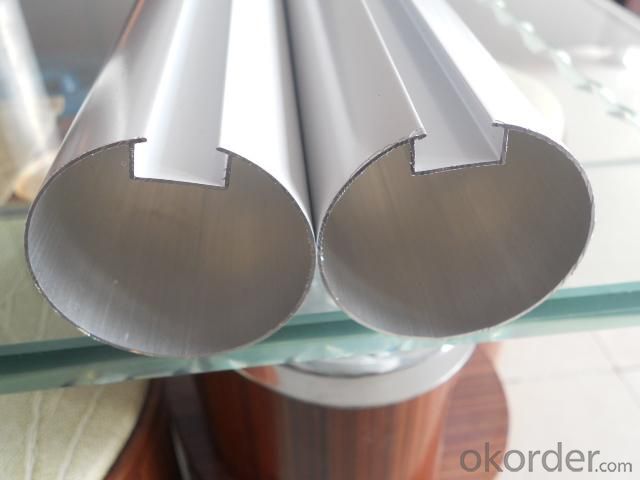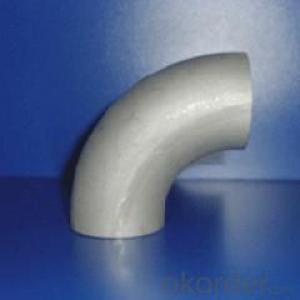T-Slot Aluminum Profiles for Anodized Aluminum Tubes Used on Furniture
- Loading Port:
- Shanghai
- Payment Terms:
- TT OR LC
- Min Order Qty:
- 5 m.t.
- Supply Capability:
- 500 m.t./month
OKorder Service Pledge
OKorder Financial Service
You Might Also Like
Specifications
Specifications
1.Type:Anodized aluminium tube
2.Thickness: 0.7mm
3.Temper:T3-T8
Specifications of Anodized Aluminum Tube:
1. Grade : 6063, 6061, 6060, 6005, 6005A, etc
2. Temper :T4, T5 or T6
3. Various colors :sliver, bronze, black, gold, blue, gray, champagne, bright, etc
4. Machining :cutting, punching, drilling, tapping, milling, bending
5. Wall thickness : 0.2mm-150mm or custom
6. Surface Treatment : Anodized,brushed,mill finished,polished, powder coated, sand blast, etc
7. Length :1m-12m
8. Outer Diameter : 4mm-2500mm
Applications of Anodized Aluminum Tube:
1.Agricultural
2.Electronics
3.Tower buildings
4.Material
5.Aviation fixtures
6.Automobile
7.Mechanical
8.Trucks
9.Ships
10.Aluminum window
11.Door
12.Curtain wall
Package of Anodized Aluminum Tube:
SMC Products are packed and labeled according to the regulations and customer's requests. Great care is taken to avoid any damage which might be caused during storage or transportation. In addition, clear labels are tagged on the outside of the packages for easy identification of the product I. D. and quality information.
1)SMC Standard
2)Customization
- Q: What are the standard dimensions of aluminum profiles?
- The standard dimensions of aluminum profiles can vary depending on the specific application and industry. However, some common standard dimensions include widths ranging from 10mm to 200mm and heights ranging from 10mm to 100mm. The length of aluminum profiles can also vary, with standard lengths typically ranging from 2 meters to 6 meters. It is important to note that these dimensions can be customized to meet specific project requirements.
- Q: Can aluminum profiles be used in agricultural greenhouse manufacturing?
- Indeed, agricultural greenhouse manufacturing can utilize aluminum profiles. Aluminum, known for its lightweight and durable nature, possesses corrosion resistance, rendering it a suitable material for greenhouse constructions. By employing aluminum profiles, one can establish the greenhouse's framework, which offers both structural support and stability. Furthermore, the flexibility and ease of customization and assembly of aluminum profiles facilitate various designs for greenhouses. Ultimately, incorporating aluminum profiles in agricultural greenhouse manufacturing guarantees enduring and efficient structures for plant cultivation.
- Q: This question asks about the variety of dimensions and forms that aluminum profiles can come in.
- <p>Aluminum profiles are available in a wide range of sizes and shapes to suit various applications. Common shapes include rectangular, square, circular, and special profiles like angles, channels, and tees. Sizes can vary from thin strips to thick bars, with specific dimensions tailored to the needs of the project. The profiles can be flat, hollow, or have complex cross-sectional geometries. They are also available in different surface finishes, such as anodized, painted, or powder-coated, to enhance their appearance and durability. The selection of aluminum profiles depends on the structural requirements, design specifications, and the industry they are intended for, such as construction, automotive, or aerospace.</p>
- Q: Are aluminum profiles resistant to impact?
- Yes, aluminum profiles are generally resistant to impact. Aluminum is known for its high strength-to-weight ratio, meaning it is strong and durable while still being lightweight. This makes it an excellent choice for applications where impact resistance is important, such as in the construction industry for window frames, doors, and curtain walls. Additionally, aluminum profiles can be further enhanced with various surface treatments and coatings to improve their impact resistance even more. However, it is worth noting that the specific impact resistance of an aluminum profile can vary depending on its thickness, design, and any additional reinforcements that may be used.
- Q: What are the applications of aluminum profiles?
- Aluminum profiles have a wide range of applications in various industries due to their unique characteristics and properties. Some of the main applications of aluminum profiles include: 1. Construction: Aluminum profiles are extensively used in the construction industry for windows, doors, curtain walls, and structural components. They provide excellent strength, durability, and resistance to corrosion, making them ideal for building purposes. 2. Automotive: Aluminum profiles are used in the automotive industry for manufacturing lightweight and fuel-efficient vehicles. They are utilized in the production of car frames, engine mounts, heat exchangers, and other structural components. 3. Aerospace: Aluminum profiles find significant applications in the aerospace industry due to their high strength-to-weight ratio. They are used in the construction of aircraft frames, wings, fuselage, and other critical components. 4. Electrical and Electronics: Aluminum profiles are widely used in electrical and electronics applications. They are utilized in the manufacturing of heat sinks, LED lighting fixtures, electrical enclosures, and electronic device housings due to their excellent thermal conductivity and electrical insulation properties. 5. Furniture: Aluminum profiles are increasingly being used in the furniture industry for manufacturing lightweight and stylish furniture pieces. They are utilized in the production of chairs, tables, cabinets, and shelving systems, providing a modern and aesthetic appeal. 6. Industrial Machinery: Aluminum profiles are extensively used in the manufacturing of industrial machinery and equipment. They are utilized in the construction of conveyor systems, assembly line structures, machine frames, and guarding systems due to their lightweight, durability, and ease of fabrication. 7. Marine: Aluminum profiles are commonly used in the marine industry due to their corrosion resistance and lightweight properties. They are utilized in the construction of boat frames, masts, hulls, and other marine structures. 8. Renewable Energy: Aluminum profiles find applications in renewable energy systems such as solar panels and wind turbines. They are used in the manufacturing of solar panel frames, wind turbine supports, and mounting structures due to their lightweight and corrosion resistance. Overall, aluminum profiles offer a versatile and cost-effective solution for various industries, catering to their specific requirements for strength, durability, lightweight, and corrosion resistance.
- Q: Are aluminum profiles suitable for use in roofing systems in areas with high wind conditions?
- <p>Yes, aluminum profiles can be used for roofing systems in windy regions. Aluminum is a lightweight and durable material that can withstand high winds. It is often used in the construction of roofing systems because of its strength and resistance to corrosion. Additionally, aluminum profiles can be designed to meet specific wind load requirements, making them suitable for areas prone to strong winds. However, the design and installation of the roofing system must be done correctly to ensure it can handle the wind forces.</p>
- Q: What are the different methods of joining aluminum profiles together?
- There are several methods of joining aluminum profiles together, depending on the specific application and desired outcome. Some of the most common methods include: 1. Mechanical fastening: This method involves using screws, bolts, or rivets to secure the aluminum profiles together. It is a simple and cost-effective method, suitable for various applications. However, it may leave visible fasteners and require additional finishing. 2. Welding: Aluminum profiles can be joined through various welding techniques, such as TIG (Tungsten Inert Gas), MIG (Metal Inert Gas), or laser welding. Welding provides a strong and seamless joint, making it suitable for structural applications. However, it requires specialized equipment and expertise. 3. Adhesive bonding: Adhesives specifically designed for aluminum bonding can be used to join profiles together. This method offers high strength, uniform distribution of stress, and a clean aesthetic appearance. Adhesive bonding is commonly used for lightweight applications or when welding is not feasible. 4. Slotting and interlocking: Aluminum profiles with specially designed slots or interlocking features can be joined together without the need for additional hardware. This method provides a clean and seamless appearance while maintaining structural integrity. 5. Thermal joining: Heat-based methods such as hot plate welding or induction heating can be used to join aluminum profiles. These processes involve melting a portion of the aluminum surface and bonding it together upon cooling. Thermal joining offers high strength and aesthetics without the need for additional materials. 6. Extrusion-based connectors: Extrusion connectors are specially designed components that allow aluminum profiles to be joined together. These connectors are typically inserted into the profile's slots or channels, providing a secure and durable connection. It is important to consider factors such as strength requirements, appearance, ease of assembly, and cost when selecting the appropriate method for joining aluminum profiles. Each method has its advantages and limitations, so choosing the most suitable method depends on the specific application and desired outcome.
- Q: Can aluminum profiles be used in exhibition or trade show displays?
- Yes, aluminum profiles can be used in exhibition or trade show displays. Aluminum profiles are lightweight, durable, and versatile, making them an ideal choice for constructing exhibition displays. They can be easily assembled and disassembled, allowing for quick setup and dismantling at trade shows. Additionally, aluminum profiles can be customized to create various shapes and sizes, accommodating different exhibition booth designs. The profiles can also be easily integrated with other materials such as fabric, glass, or acrylic panels to create a visually appealing and professional display. Overall, aluminum profiles offer a cost-effective and practical solution for exhibition or trade show displays.
- Q: Can aluminum profiles be used for agricultural or farming applications?
- Yes, aluminum profiles can be used for agricultural or farming applications. Aluminum is lightweight, durable, and corrosion-resistant, making it suitable for various agricultural equipment and structures such as greenhouse frames, irrigation systems, storage sheds, and livestock enclosures. Additionally, aluminum profiles can be easily fabricated and customized to meet specific farming needs, making them a versatile choice for agricultural applications.
- Q: The latest list of aluminum China
- The first aluminum aluminum (China Aluminum Group, the central management of large state-owned enterprises)Second of Asia Aluminum (Asia Aluminum Group, Asia's largest aluminum producer, Chinese brand)Third strong aluminum products (China famous brand, national inspection free products)Fourth (Chinese Fenglv aluminum material brand, national Mianjian products)Fifth Zhong Zhong aluminum (China famous brand, China well-known trademark, national inspection free products)Sixth (Chinese Hing Fat aluminum brand, A Well-Known Trademark in China, national Mianjian products)Seventh South Asia Aluminum profiles (China famous brand, national inspection free products)Eighth Nanshan aluminum (China famous brand, China well-known trademark, national inspection free products)Ninth by court aluminum profiles (China well-known trademarks, national inspection free products)Albert tenth aluminum (China famous brand, national inspection free products)
Send your message to us
T-Slot Aluminum Profiles for Anodized Aluminum Tubes Used on Furniture
- Loading Port:
- Shanghai
- Payment Terms:
- TT OR LC
- Min Order Qty:
- 5 m.t.
- Supply Capability:
- 500 m.t./month
OKorder Service Pledge
OKorder Financial Service
Similar products
Hot products
Hot Searches
Related keywords






























